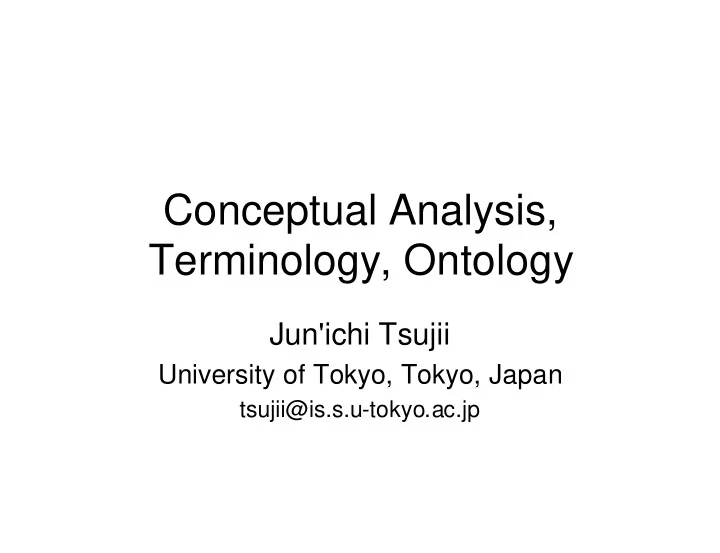

Conceptual Analysis, Terminology, Ontology Jun'ichi Tsujii University of Tokyo, Tokyo, Japan tsujii@is.s.u-tokyo.ac.jp
Challenges • Tools for terminologies, supported by large corpora (Medline, BioMed Central) and NLP techniques • Feasibility of the tools for real world applications – Bioinformatics, Clinical bioinformatics, Health-care – e-Science, e-Learning, e-Education – From successful seeds (eg: IR), from real needs (eg: Bioinformatics) • Linking terminology with other technologies – Semantic web, Grid (from sharing computational power to sharing knowledge and data)
Possible contribution of NLP (1)Recognizing terms (70% with semantic class recognition) -- from techniques dependent on subject domains to those independent ones -- integration of larger structures (2) Gathering related terms and term variants -- Machine Learning (semi-unsupervised) (3) Gathering semantic similar terms -- Knowledge discovery from Web to that from specialized subject domains (4) NER for gathering new terms (5) Large discrepancy between the concept domain and the language domain (6) Expressions in context
Experiment (Gathering Terms) Automatic learning of rules Automatic learning of rules of spelling variations of term variations [Tsuruoka, SIGIR 03] [Tsuruoka, Applied bioinformatics 04] • Corpus • Training Data – MEDLINE: the largest collection of abstracts in the – Meta-thesaurus biomedical domain – Variant pairs with the same • Rule learning concept IDs – 83,142 abstracts – Under “Amino acid or protein”, – Obtained rules: 14,158 – 36,112 variant pairs • Evaluation • Rule induced – 18,930 abstracts – Rules: 4,780,793 rules – Count the occurrences • Evaluation of each generated – Matching against running texts variant .
1.000 NF kappa B 128 0.500 Transcription Factor NF kappa B 0 0.429 NF-kappa B 912 0.286 NF kB, Transcription Factor 0 0.286 NF kB 0 0.286 Immunoglobulin Enhancer-Binding Protein 0 0.286 Immunoglobulin Enhancer Binding Protein 0 0.286 Enhancer-Binding Protein, Immunoglobulin 0 0.286 kappa B Enhancer Binding Protein 0 0.286 Transcription Factor NF-kB 0 0.286 Transcription Factor NF kB 0 0.286 Factor NF-kB, Transcription 0 0.286 nuclear factor kappa beta 2 0.286 NF kappaB 1 0.273 NF kappa B chain 0 0.273 NF kappa B subunit 0 0.214 Transcription Factor NF-kappa B 0 0.214 NF-kB, Transcription Factor 0 0.214 NF-kB 67 0.200 Neurofibromatosis Type kappa B 0
1.000 tumor necrosis factor A 0 0.316 TNF A 1 0.200 tumor necrosis factor 1653 0.158 TNF alpha 358 0.133 TNFA 32 0.133 TNF 2631 0.133 Tumour necrosis factor alpha 14 0.133 Tumor Necrosis Factor alpha 2 0.133 Tumor Necrosis Factor-Alpha 0 0.133 TUMOR NECROSIS FACTOR.ALPHA 0 0.133 Tumor necrosis factor alpha 52 0.133 Tumor Necrosis Factor-alpha 8 0.133 TNF-Alpha 0 0.133 TNF-alpha 6899
A cluster of realizations of terms Language Domain Concept Domain Homologues/Orthologues Process of Ribosomal subunit assembly
Term: Ribosomal large subunit assembly and maintenance and in its absence, deficient 60 S ribosomes are assembled which are inactive in protein synthesis resulting in cell lethality . Mutations that completely abolish recognition of 26 S rRNA, however, block the formation of 60S particles, demonstrating that binding of L25 to this rRNA is an essential step in the assembly of the large ribosomal subunit. Depletion of Saccharmoyces cerevisiae ribosomal protein L16 causes decrease in 60S ribosomal subunits and formation of half-mer polyribosomes. Without L3, apparent synthesis of several 60 S subunit proteins diminished, and 60S subunit did not assemble. A similar phenomenon occurred, when a second strain, synthesis of ribosomal protein L29 was prevented.
Recommend
More recommend